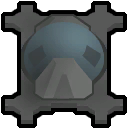Ground-penetrating scanner
Ground-penetrating scanner
A sensor unit used by researchers to search for buried resources. The chance to find a resource depends on the operator's research ability. It consumes a lot of electricity. If you find a buried resource, you'll need to use deep drills to extract it. It doesn't work under a roof.
Base Stats
Building
- Size
- 3 × 3
- Minifiable
- False
- Placeable
- True
- Passability
- pass through only
- Cover Effectiveness
- 40%
- Terrain Affordance
- Heavy
- Power
- -700 W
Creation
- Required Research
- Ground-penetrating scanner
- Skill Required
- Construction 8
- Work To Make
- 12,000 ticks (3.33 mins)
- Destroy yield
- nothing
A ground-penetrating scanner detects and illuminates underground deposits of resources, which can be mined with a deep drill.
Acquisition
Ground-penetrating scanners can be constructed once the Ground-penetrating scanner research project has been completed. They require ![]() 150 Steel,
150 Steel, ![]() 4 Components,
4 Components, ![]() 1 Advanced component, 12,000 ticks (3.33 mins) of work, and a Construction skill of 8.
1 Advanced component, 12,000 ticks (3.33 mins) of work, and a Construction skill of 8.
Summary
Ground-penetrating scanners consume 700 W of power and do not function under a roof. Scanning falls under Intellectual work. When operating a ground scanner, there is a mean of 180,000 ticks (3 in-game days) of work to find a deposit of ores. Finding a deposit is guaranteed after 360,000 ticks (6 in-game days) of work. These values are then modified by the Research Speed of the users in question. These ores can be mined with a deep drill.
Scanners technically create ore deposits. You will never find ores with a deep drill without a scanner, and scanners can find an infinite amount of resources in a given map. Ores and their extraction are not affected in any way by the existence of ice.
Ores
The resources contained in a deposit correlates with the size of the deposit. Each cell of resources contains 300 units of the resource. Below is an estimate of the different deposit sizes:
| Resource | Deposit Size | Deposit Mean | Commonality | Portion Size | Avg Deposit Return |
|---|---|---|---|---|---|
| 20 - 40 | ~ 30 | 4 | 35 | ||
| 7 - 20 | ~ 14 | 0.5 | 40 | ||
| 2 - 10 | ~ 7 | 1 | 7 | ||
| 1 - 5 | ~ 3 | 0.5 | 10 | ||
| 1 - 5 | ~ 3 | 0.5 | 10 | ||
| 4 - 10 | ~ 7 | 1 | 10 |
Alternative table:
| Resource | 1-5 | 6-10 | 11-15 | 16-20 | 21-30 | 31-40 |
|---|---|---|---|---|---|---|
| - | - | - | - | |||
| - | - | - | ||||
| - | - | - | - | - | ||
| - | - | - | - | - | ||
| - | - | - | - | |||
| - | - | - | - |
Analysis
Ground-penetrating scanners can provide a massive amount of resources. Trade is finite, ore deposits inside rock are finite, but a scanner + deep drill can find massive quantities of drillable steel, plasteel, and other useful metals without ever leaving the map. These metals can bottleneck a colony's progress. As long as you have a decent miner, a ground scanner or two is a worthwhile investment.
The ground-penetrating scanner is not usable if there is a roof over it. Scanners can be placed in rooms if you need to regulate the temperature; the open roof will make heating inefficient, but it is possible. Having a larger room with double-thick walls allows for more efficient heating.
Comparison to long-range scanners
The long-range mineral scanner can find readily mineable ores on the world map, as opposed to ores that need to be drilled. The long-ranged scanner costs the same research as Deep Drill + Ground Scanner combination, though the former is required to research Starflight Sensors.
The first comparison is of convenience; ground-penetrating scanners create much more ore per deposit (9000 vs 2300 average steel), find ores roughly 60,000 ticks (24 in-game hours) faster than the long-range, and you don't have to leave your colony to access it. Meanwhile, long-range scanners require a caravan or transport pods to travel to, and the weight of all the ore can be an issue. Pack animals are often necessary to carry all the ores back.
However, long-range scanners can be tuned to a specific material, while ground scanners will find ores randomly. In addition, drilling ores takes much longer than mining ores from a long-range scanner. Drilling also can trigger the Too Deep: Infestation event, while a caravan can be ambushed.
Version history
- Beta 19 - power usage was significantly reduced from 1500W to 800W. Its build cost was also changed, previously costing 400 steel and 12 components.
- 1.1.0 - Reworked; previously it showed all minerals on the map instantly. Now it requires work by a pawn and will periodically find new mineral patches, forever. Its power cost was also slightly lowered to 700W.
- 1.1.2564 - Rebalance. Random find time 4 work days->3 work days. Guaranteed find time 8 work days -> 6 work days. Now displays feedback about the current user's scanning speed, the random scan interval for this user, and the progress to a guaranteed find.
